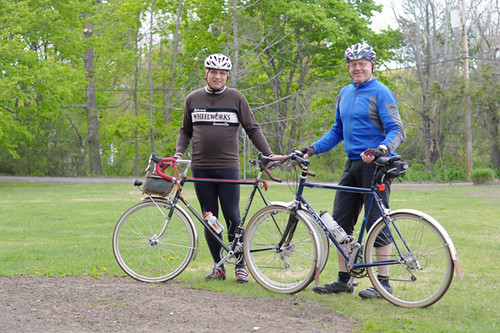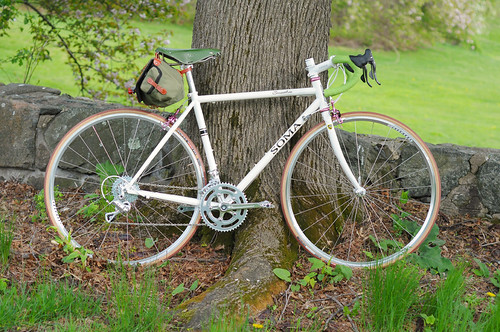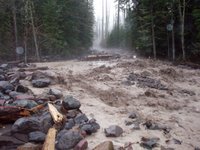
No sooner had I returned from New York over the weekend, than the Soma Smothie I'd been anticipating for review had arrived. So I took a break from the loop frame delirium of the New Amsterdam Bicycle Show and immediately took it for a spin. Soma roadbikes are not very common here on the East Coast. So imagine my surprise when on my way home I encountered another Smoothie!

As I stopped to snap some pictures at the end of my ride, these gentlemen recognised me and we had a nice chat about their 650B conversions - one a vintage Andre Bertin and the other a Soma Smoothie ES with a Bontrager fork. I am so happy to be back home! Where else but in Boston does one encounter this sort of thing?

But enough about other people's bikes for now, and here is more about the one I am riding. This Soma Smoothie is on loan for review directly from the manufacturer. It is a 52cm steel frameset that was built up to accommodate my Campagnolo lever preferences, which was very nice of them. Everything shown on the bike is directly from Soma, except for my bag and pedals.

I have not weighed the bike yet, but (without saddlebag) it feels pretty similar to my vintage Moser - so I'd say around 21lb.Described as a road/race frame, the Smoothie nonetheless has eyelets for fenders and clearances for 28mm tires.

One thing it does't have? Toe overlap! That's right: Here is a stock 52cm road/racing bike with no TCO. They exist. I wear size 37-38 shoes and with 23mm tires there is a boatload of clearance (well maybe it's a small boat, but still). I can definitely fit it with 25mms without a problem, maybe even 28mm.

The pearly white colourscheme is adaptable to a wide range of aesthetics, from classic to colourful to stark. The TIG welded frame will not satisfy lug lovers but is solid and smooth-jointed. It is a versatile, unobtrusive frameset. A carbon fork is available in place of the standard steel one for those wishing to go that route.

This is not a review, so I won't go over the details of the build at this stage. But as far as first impressions (and mind you this is after just 25 miles), a couple of things stand out: First, it is smooth - as advertised. And I am talking about ride quality: very comfy over bumps and I do not feel any road vibration. And second, it handles tamely and predictably. No twitchiness and very precise cornering at the moderate speeds maintained during my conservative "shake down" ride.

The Smothie ES owner I met on the road is very happy with his bicycle, which he's got outfitted with 32mm tires and fenders. I will refrain from writing more about the bike I have on loan until I ride it extensively, but at under $400 for the frame, I am impressed so far. We need more of these on the East Coast and I hope some local shops will carry floor models in the near future.
 The dogs have been taught not to tear up anything so they didn't want to open their gifts but the cats didn't hesitate when offered the chance of opening gifts and playing in gift wrap paper.
The dogs have been taught not to tear up anything so they didn't want to open their gifts but the cats didn't hesitate when offered the chance of opening gifts and playing in gift wrap paper.






 The dogs have been taught not to tear up anything so they didn't want to open their gifts but the cats didn't hesitate when offered the chance of opening gifts and playing in gift wrap paper.
The dogs have been taught not to tear up anything so they didn't want to open their gifts but the cats didn't hesitate when offered the chance of opening gifts and playing in gift wrap paper.






 Mendenhall Glacier as seen from the rear of my campsite at Mendenhall Lake campground in the Tongass National Forest. The full face of the glacier cannot be seen from this vantage point because it is blocked by the bit of land jutting out from the left.
Mendenhall Glacier as seen from the rear of my campsite at Mendenhall Lake campground in the Tongass National Forest. The full face of the glacier cannot be seen from this vantage point because it is blocked by the bit of land jutting out from the left. The view from the Visitors Center. We are seeing only a very small portion of the glacier as it extends 12 miles back down the valley.
The view from the Visitors Center. We are seeing only a very small portion of the glacier as it extends 12 miles back down the valley. A little bit closer.
A little bit closer. An awesome waterfall flows down from above. Another waterfall can be seen in the far distance to the right of the glacier.
An awesome waterfall flows down from above. Another waterfall can be seen in the far distance to the right of the glacier. A ride on the lake gets you a little closer to the face of the glacier.
A ride on the lake gets you a little closer to the face of the glacier. Some of the larger icebergs floating in Mendenhall Lake. Icebergs are created when the glacier calves (chunks of ice fall off the face of the glacier).
Some of the larger icebergs floating in Mendenhall Lake. Icebergs are created when the glacier calves (chunks of ice fall off the face of the glacier). I couldn't resist picking up a chunk of glacial ice that was floating close to the shore. It was crystal clear and many, many years old. And it was cold...
I couldn't resist picking up a chunk of glacial ice that was floating close to the shore. It was crystal clear and many, many years old. And it was cold...
 I think that this red vase may be depression glass or carnival glass. Other than that I know nothing about it.
I think that this red vase may be depression glass or carnival glass. Other than that I know nothing about it.













 The rain seems to have stopped and now you can hear the Longmire generators (6-10 am and 4-8 pm that is). It's going to take some time to put things back in order, but it seems as though the main brunt of the storm and its damage have subsided.
The rain seems to have stopped and now you can hear the Longmire generators (6-10 am and 4-8 pm that is). It's going to take some time to put things back in order, but it seems as though the main brunt of the storm and its damage have subsided.  If you're familiar with the park, you'll notice a number of "new viewing areas" along the Nisqually to Paradise corridor next time you visit. The Nisqually River ran bank to bank and in doing so, took a massive amount of debris with it. Large trees fell, as new embankments were chiseled.
If you're familiar with the park, you'll notice a number of "new viewing areas" along the Nisqually to Paradise corridor next time you visit. The Nisqually River ran bank to bank and in doing so, took a massive amount of debris with it. Large trees fell, as new embankments were chiseled. 











 There are a number of climbing conditions updates now that the mountaineering rangers are regularly patrolling the standard routes. The Gibraltar Ledges, Emmons, DC, and Kautz were all climbed last week and we still welcome your reports if you're out and about...
There are a number of climbing conditions updates now that the mountaineering rangers are regularly patrolling the standard routes. The Gibraltar Ledges, Emmons, DC, and Kautz were all climbed last week and we still welcome your reports if you're out and about... A calm section of the South Fork Kings River. The big boulder in the distance is known as the Muir Rock. From this wide, flat rock, John Muir used to deliver impassioned speeches about the Sierra. When referring to logging the giant trees, he said that mankind may as well "sell the rain clouds and the snow and the rivers to be cut up and carried away, if that were possible."
A calm section of the South Fork Kings River. The big boulder in the distance is known as the Muir Rock. From this wide, flat rock, John Muir used to deliver impassioned speeches about the Sierra. When referring to logging the giant trees, he said that mankind may as well "sell the rain clouds and the snow and the rivers to be cut up and carried away, if that were possible." Narrow spots in the river, along with boulders and rocks in the water, create sections of rough water. I love the sound of the water flowing through these areas.
Narrow spots in the river, along with boulders and rocks in the water, create sections of rough water. I love the sound of the water flowing through these areas. There were some areas along the trail that required scrambling over rocks, but for the most part the trail was relatively level with open meadows mingled with forested areas. About three quarters of the way down the trail there were several small streams that had to be crossed using rocks as stepping stones, or simply walking through the shallow, swift flowing waters.
There were some areas along the trail that required scrambling over rocks, but for the most part the trail was relatively level with open meadows mingled with forested areas. About three quarters of the way down the trail there were several small streams that had to be crossed using rocks as stepping stones, or simply walking through the shallow, swift flowing waters. But then I came to this. The three logs were 8-10 feet long. The water was about 18” deep and very, very fast. I stuck my hiking stick in to the bottom of the stream and the current almost grabbed it out of my hand. It's hard to see in the photo but once you got across the wet, slippery logs there was a downed tree that you had to get over and another 10 feet or so of water (though it didn't look quite as deep) before you reached the other side.
But then I came to this. The three logs were 8-10 feet long. The water was about 18” deep and very, very fast. I stuck my hiking stick in to the bottom of the stream and the current almost grabbed it out of my hand. It's hard to see in the photo but once you got across the wet, slippery logs there was a downed tree that you had to get over and another 10 feet or so of water (though it didn't look quite as deep) before you reached the other side.







